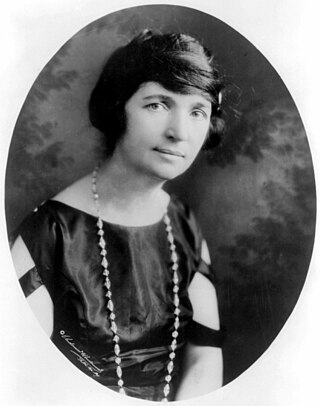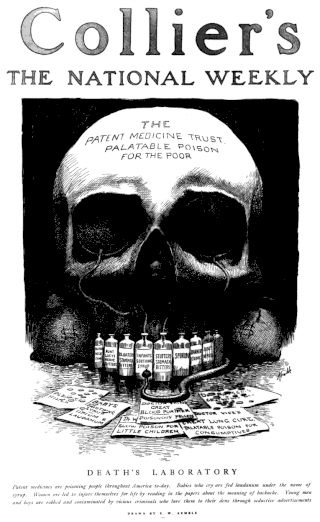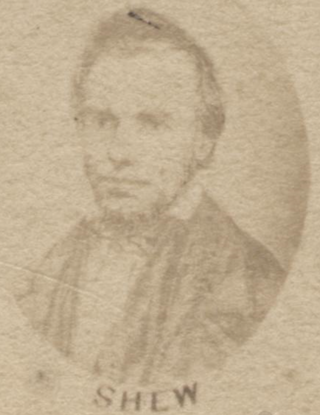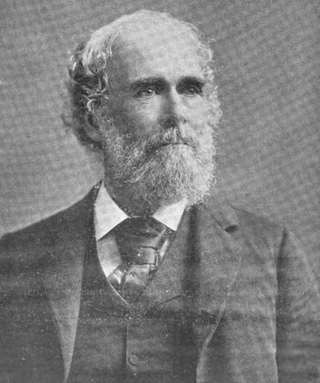Related Research Articles

A disease is a particular abnormal condition that negatively affects the structure or function of all or part of an organism and is not immediately due to any external injury. Diseases are often known to be medical conditions that are associated with specific signs and symptoms. A disease may be caused by external factors such as pathogens or by internal dysfunctions. For example, internal dysfunctions of the immune system can produce a variety of different diseases, including various forms of immunodeficiency, hypersensitivity, allergies, and autoimmune disorders.

Margaret Higgins Sanger, also known as Margaret Sanger Slee, was an American birth control activist, sex educator, writer, and nurse. Sanger popularized the term "birth control", opened the first birth control clinic in the United States, and established organizations that evolved into the Planned Parenthood Federation of America.
Griswold v. Connecticut, 381 U.S. 479 (1965), was a landmark decision of the U.S. Supreme Court in which the Court ruled that the Constitution of the United States protects the liberty of married couples to buy and use contraceptives without government restriction. The case involved a Connecticut "Comstock law" that prohibited any person from using "any drug, medicinal article or instrument for the purpose of preventing conception". The court held that the statute was unconstitutional, and that its effect was "to deny disadvantaged citizens ... access to medical assistance and up-to-date information in respect to proper methods of birth control." By a vote of 7–2, the Supreme Court invalidated the law on the grounds that it violated the "right to marital privacy", establishing the basis for the right to privacy with respect to intimate practices. This and other cases view the right to privacy as "protected from governmental intrusion".

The Comstock laws are a set of federal acts passed by the United States Congress under the Grant administration along with related state laws. The "parent" act was passed on March 3, 1873, as the Act for the Suppression of Trade in, and Circulation of, Obscene Literature and Articles of Immoral Use. This Act criminalized any use of the U.S. Postal Service to send any of the following items: obscenity, contraceptives, abortifacients, sex toys, personal letters with any sexual content or information, or any information regarding the above items.

A patent medicine is a non-prescription medicine or medicinal preparation that is typically protected and advertised by a trademark and trade name, and claimed to be effective against minor disorders and symptoms, as opposed to an ethical drug that could be obtained only through a pharmacist, usually with a doctor's prescription, and whose composition was openly disclosed. Many over-the-counter medicines were once ethical drugs obtainable only by prescription, and thus are not patent medicines.

Anthony Comstock was an anti-vice activist, United States Postal Inspector, and secretary of the New York Society for the Suppression of Vice (NYSSV), who was dedicated to upholding Christian morality. He opposed obscene literature, abortion, contraception, masturbation, gambling, prostitution, and patent medicine. The terms comstockery and comstockism refer to his extensive censorship campaign of materials that he considered obscene, including birth control advertised or sent by mail. He used his positions in the U.S. Postal Service and the NYSSV to make numerous arrests for obscenity and gambling. Besides these pursuits, he was also involved in efforts to suppress fraudulent banking schemes, mail swindles, and medical quackery.
A panacea, named after the Greek goddess of universal remedy Panacea, is any supposed remedy that is claimed to cure all diseases and prolong life indefinitely. It was in the past sought by alchemists in connection with the elixir of life and the philosopher's stone, a mythical substance that would enable the transmutation of common metals into gold. Through the 18th and 19th centuries, many "patent medicines" were claimed to be panaceas, and they became very big business. The term "panacea" is used in a negative way to describe the overuse of any one solution to solve many different problems, especially in medicine. The word has acquired connotations of snake oil and quackery.

Preventive healthcare, or prophylaxis is the application of healthcare measures to prevent diseases. Disease and disability are affected by environmental factors, genetic predisposition, disease agents, and lifestyle choices, and are dynamic processes which begin before individuals realize they are affected. Disease prevention relies on anticipatory actions that can be categorized as primal, primary, secondary, and tertiary prevention.

Respiratory diseases, or lung diseases, are pathological conditions affecting the organs and tissues that make gas exchange difficult in air-breathing animals. They include conditions of the respiratory tract including the trachea, bronchi, bronchioles, alveoli, pleurae, pleural cavity, the nerves and muscles of respiration. Respiratory diseases range from mild and self-limiting, such as the common cold, influenza, and pharyngitis to life-threatening diseases such as bacterial pneumonia, pulmonary embolism, tuberculosis, acute asthma, lung cancer, and severe acute respiratory syndromes, such as COVID-19. Respiratory diseases can be classified in many different ways, including by the organ or tissue involved, by the type and pattern of associated signs and symptoms, or by the cause of the disease.

Birth control, also known as contraception, anticonception, and fertility control, is the use of methods or devices to prevent unintended pregnancy. Birth control has been used since ancient times, but effective and safe methods of birth control only became available in the 20th century. Planning, making available, and using human birth control is called family planning. Some cultures limit or discourage access to birth control because they consider it to be morally, religiously, or politically undesirable.
The Popular Health Movement of the 1830s–1850s was an aspect of Jacksonian-era politics and society in the United States. The movement promoted a rational skepticism toward claims of medical expertise that were based on personal authority, and encouraged ordinary people to understand the pragmatics of health care. Arising in the spirit of Andrew Jackson's anti-elitist views, the movement succeeded in ending almost all government regulation of health care. During the first two decades of the 19th century, states had regularly enacted licensing legislation; by 1845, only three states still licensed medical doctors. Among the leading figures within the movement were Samuel Thomson and Sylvester Graham.

The womb veil was a 19th-century American form of barrier contraception consisting of an occlusive pessary, i.e. a device inserted into the vagina to block access of the sperm into the uterus. Made of rubber, it was a forerunner to the modern diaphragm and cervical cap. The name was first used by Edward Bliss Foote in 1863 for the device he designed and marketed. "Womb veil" became the most common 19th-century American term for similar devices, and continued to be used into the early 20th century. Womb veils were among a "range of contraceptive technology of questionable efficacy" available to American women of the 19th century, forms of which began to be advertised in the 1830s and 1840s. They could be bought widely through mail-order catalogues; when induced abortion was criminalized during the 1870s, reliance on birth control increased. Womb veils were touted as a discreet form of contraception, with one catalogue of erotic products from the 1860s promising that they could be "used by the female without danger of detection by the male."

Edward Bliss Foote was an American doctor, author, and advocate for birth control.

The birth control movement in the United States was a social reform campaign beginning in 1914 that aimed to increase the availability of contraception in the U.S. through education and legalization. The movement began in 1914 when a group of political radicals in New York City, led by Emma Goldman, Mary Dennett, and Margaret Sanger, became concerned about the hardships that childbirth and self-induced abortions brought to low-income women. Since contraception was considered to be obscene at the time, the activists targeted the Comstock laws, which prohibited distribution of any "obscene, lewd, and/or lascivious" materials through the mail. Hoping to provoke a favorable legal decision, Sanger deliberately broke the law by distributing The Woman Rebel, a newsletter containing a discussion of contraception. In 1916, Sanger opened the first birth control clinic in the United States, but the clinic was immediately shut down by police, and Sanger was sentenced to 30 days in jail.
The Free Speech League was a progressive organization in the United States that fought to support freedom of speech in the early 20th century. The League focused on combating government censorship, particularly relating to political speech and sexual material. It was a predecessor of the American Civil Liberties Union.

William Lambe was an English physician and early veganism activist. He has been described as a pioneer of vegan nutrition.
Sanford Bennett (1841–1926) was an American businessman and writer associated with the physical culture movement, best known for his publications on anti-aging and natural hygiene.

Joel Shew was an American physician, hydrotherapist and natural hygiene advocate.

Emmet Densmore was an American businessman, physician and natural hygiene advocate who promoted an early version of the Paleolithic diet.

Martin Luther Holbrook was an American physician and vegetarianism activist associated with the natural hygiene and physical culture movements.
References
- ↑ VJ., Cirillo (1970). "Edward Foote's Medical Common Sense: an early American comment on birth control". Journal of the History of Medicine and Allied Sciences. 25 (3): 341–345. doi:10.1093/jhmas/xxv.3.341. PMID 4912885.
- ↑ Wood, Janice (2008). "Prescription for a Periodical: Medicine, Sex, and Obscenity in the Nineteenth Century, As Told in "Dr. Foote's Health Monthly"". American Periodicals. 18 (1): 27. doi:10.1353/amp.2008.0009. JSTOR 41219785. S2CID 71402567.
- ↑ Hoolihan, Christopher (2002). An Annotated Catalogue of the Edward C. Atwater Collection of American Popular Medicine and Health Reform: Volume I, A-L. University of Rochester Press. p. 336. ISBN 1580460984 . Retrieved 7 October 2015.
- 1 2 3 Rabban, David M. (1992). "The Free Speech League, the ACLU, and Changing Conceptions of Free Speech in American History". Stanford Law Review. 45 (1): 67–68. doi:10.2307/1228985. JSTOR 1228985.
- ↑ Brodie, Janet F. (1997). Contraception and Abortion in Nineteenth-century America. Cornell University Press. pp. 238–239. ISBN 0801484332.
- ↑ Hoolihan, Christopher; Atwater, Edward C. (2001). An Annotated Catalogue of the Edward C. Atwater Collection of American Popular Medicine and Health Reform: A-L. University Rochester Press. p. 335. ISBN 1580460984.
- ↑ Edelstein, Sari (2015). "Louisa May Alcott's Age". American Literature. 87 (3): 519–520. doi:10.1215/00029831-3149357.
- 1 2 3 Rabban, David (1999). Free Speech in Its Forgotten Years, 1870-1920. Cambridge University Press. p. 39. ISBN 9780521655378 . Retrieved 7 October 2015.
- ↑ Foote, Edward Bliss (1 February 1865). "More Letters From the People: If You Want To Know What People Think of Medical Common Sense". New York Times (subscription required). ProQuest 91933178.
- ↑ Silberman, Marsha (2009). "The Perfect Storm: Late Nineteenth-Century Chicago Sex Radicals: Moses Harman, Ida Craddock, Alice Stockham and the Comstock Obscenity Laws". Journal of the Illinois State Historical Society. 102 (3/4): 336. JSTOR 25701240.